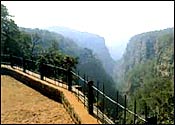|
|
|
|
|
|
|
|
|
| Indore Introduction |
|
 Indore is the capital city of the erstwhile Holkar rulers. It is an important industrial city in central India and is known as 'mini Mumbai'. There are a number of historical monuments in Indore belonging to the Holkars. Indore is also known for its temples. The architecture of the monuments in Indore is the amalgamation of different styles. River Saraswati and River Kham, which are tributaries of River Shipra, flow through Indore. Indore is the capital city of the erstwhile Holkar rulers. It is an important industrial city in central India and is known as 'mini Mumbai'. There are a number of historical monuments in Indore belonging to the Holkars. Indore is also known for its temples. The architecture of the monuments in Indore is the amalgamation of different styles. River Saraswati and River Kham, which are tributaries of River Shipra, flow through Indore.
|
|
|
Top ˆ |
|
|
| Indore Tourist Attractions |
|
|
| § Rajwada |
|
The Rajwada or the old palace, located in the old part of the city, near the bustling Khajuri Bazaar, is an important site to visit. This building is a unique blend of French, Mughal and Maratha style of architecture. This seven story, 200-year-old building reflects the glory of the Holkars. |
|
|
| § Kanch Mandir |
|
The Kanch Mandir (the temple of mirrors) or Seth Hukanchand temple is located near the Rajwada. It is a Jain temple, having plain exteriors, and contains intricate mirror work on the inside. |
|
|
| § Indore Museum |
|
The Indore Museum, located near the Main Post Office, houses a good collection of pre-medieval and medieval artifacts. The Lal Bagh Palace (built between 1886-1921) is the most important monument created by the erstwhile Holkar rulers. |
|
|
| § Chhatri Bagh |
|
The Chhatri Bagh, located near the Kham River, has a number of chhatris or memorial cenotaphs erected in memory of the erstwhile Holkar rulers and their family members. The architectural style of these chhatris is typically Marathi. |
|
|
| § Gandhi Hall |
|
Another attraction of Indore city is the Gandhi Hall or Town Hall, built in 1904. This Indo-Gothic styled building is also referred as Ghanta Ghar because it has a four-faced clock tower in the front. A number of art and cultural exhibitions are held in this building. |
|
|
|
|
|
Top ˆ |
|
|
|
|











